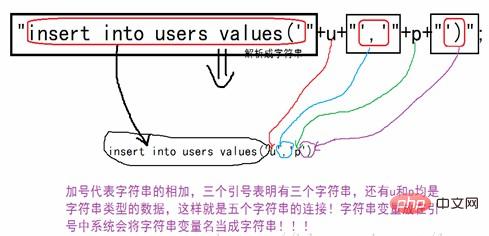
How to write java sql statement
About the splicing rules of SQL statements in Java
The implementation target statement is the following. Note that the java variable here is idd
int idd; String sql = "SELECT id, piUrl FROM picinfos WHERE id BETWEEN '" + idd + "' AND 10" ;
The string in java can only be double quoted. If a variable needs to be spliced ??in the string, the variable must be single quoted. Surround it, then add two double quotes and then two plus signs, and the variable is in the middle.
Splicing steps
1. Write the specific SQL statement (no variables have specific values), such as the above sql
//查詢picinfos表中id為2到10的id和piUrl值 String sql = "SELECT id, piUrl FROM picinfos WHERE id BETWEEN 2 AND 10" ;
2. At this time, if you want to change 2 to id (int type variable), you only need to modify it in the middle. First, delete 2 and replace
String sql = "SELECT id, piUrl FROM picinfos WHERE id BETWEEN ' ' AND 10" ;
3 with single quote ' '. Then add double quotes between the single quotes " "
String sql = "SELECT id, piUrl FROM picinfos WHERE id BETWEEN ' " " ' AND 10" ;
4. Then add a plus sign between the double quotes
String sql = "SELECT id, piUrl FROM picinfos WHERE id BETWEEN ' " + + " ' AND 10" ;
5. Finally, add the variable idd between the plus sign and finish
String sql = "SELECT id, piUrl FROM picinfos WHERE id BETWEEN ' " + idd + " ' AND 10" ;
Function: Start with the SQL prototype, replace it with single quotes, add double quotes in the middle, add double plus signs in the middle, and add variables in the middle.
So how is the Java string converted into a SQL statement?
As shown in the picture

php Chinese Internet, a large number of free Java introductory tutorials, welcome to learn online!
The above is the detailed content of How to write java sql statement. For more information, please follow other related articles on the PHP Chinese website!

Hot AI Tools

Undress AI Tool
Undress images for free

Undresser.AI Undress
AI-powered app for creating realistic nude photos

AI Clothes Remover
Online AI tool for removing clothes from photos.

Clothoff.io
AI clothes remover

Video Face Swap
Swap faces in any video effortlessly with our completely free AI face swap tool!

Hot Article

Hot Tools

Notepad++7.3.1
Easy-to-use and free code editor

SublimeText3 Chinese version
Chinese version, very easy to use

Zend Studio 13.0.1
Powerful PHP integrated development environment

Dreamweaver CS6
Visual web development tools

SublimeText3 Mac version
God-level code editing software (SublimeText3)
 How to handle transactions in Java with JDBC?
Aug 02, 2025 pm 12:29 PM
How to handle transactions in Java with JDBC?
Aug 02, 2025 pm 12:29 PM
To correctly handle JDBC transactions, you must first turn off the automatic commit mode, then perform multiple operations, and finally commit or rollback according to the results; 1. Call conn.setAutoCommit(false) to start the transaction; 2. Execute multiple SQL operations, such as INSERT and UPDATE; 3. Call conn.commit() if all operations are successful, and call conn.rollback() if an exception occurs to ensure data consistency; at the same time, try-with-resources should be used to manage resources, properly handle exceptions and close connections to avoid connection leakage; in addition, it is recommended to use connection pools and set save points to achieve partial rollback, and keep transactions as short as possible to improve performance.
 How to work with Calendar in Java?
Aug 02, 2025 am 02:38 AM
How to work with Calendar in Java?
Aug 02, 2025 am 02:38 AM
Use classes in the java.time package to replace the old Date and Calendar classes; 2. Get the current date and time through LocalDate, LocalDateTime and LocalTime; 3. Create a specific date and time using the of() method; 4. Use the plus/minus method to immutably increase and decrease the time; 5. Use ZonedDateTime and ZoneId to process the time zone; 6. Format and parse date strings through DateTimeFormatter; 7. Use Instant to be compatible with the old date types when necessary; date processing in modern Java should give priority to using java.timeAPI, which provides clear, immutable and linear
 How do you calculate the difference between two dates in SQL?
Aug 02, 2025 pm 01:29 PM
How do you calculate the difference between two dates in SQL?
Aug 02, 2025 pm 01:29 PM
To calculate the difference between two dates, you need to select the corresponding function according to the database type: 1. Use DATEDIFF() to calculate the day difference in MySQL, or specify the units such as HOUR and MINUTE in TIMESTAMPDIFF(); 2. Use DATEDIFF(date_part, start_date, end_date) in SQLServer and specify the units; 3. Use direct subtraction in PostgreSQL to obtain the day difference, or use EXTRACT(DAYFROMAGE(...)) to obtain more accurate intervals; 4. Use julianday() function to subtract the day difference in SQLite; always pay attention to the date order
 How to execute SQL queries in Python?
Aug 02, 2025 am 01:56 AM
How to execute SQL queries in Python?
Aug 02, 2025 am 01:56 AM
Install the corresponding database driver; 2. Use connect() to connect to the database; 3. Create a cursor object; 4. Use execute() or executemany() to execute SQL and use parameterized query to prevent injection; 5. Use fetchall(), etc. to obtain results; 6. Commit() is required after modification; 7. Finally, close the connection or use a context manager to automatically handle it; the complete process ensures that SQL operations are safe and efficient.
 Comparing Java Frameworks: Spring Boot vs Quarkus vs Micronaut
Aug 04, 2025 pm 12:48 PM
Comparing Java Frameworks: Spring Boot vs Quarkus vs Micronaut
Aug 04, 2025 pm 12:48 PM
Pre-formanceTartuptimeMoryusage, Quarkusandmicronautleadduetocompile-Timeprocessingandgraalvsupport, Withquarkusoftenperforminglightbetterine ServerLess scenarios.2.Thyvelopecosyste,
 How does garbage collection work in Java?
Aug 02, 2025 pm 01:55 PM
How does garbage collection work in Java?
Aug 02, 2025 pm 01:55 PM
Java's garbage collection (GC) is a mechanism that automatically manages memory, which reduces the risk of memory leakage by reclaiming unreachable objects. 1.GC judges the accessibility of the object from the root object (such as stack variables, active threads, static fields, etc.), and unreachable objects are marked as garbage. 2. Based on the mark-clearing algorithm, mark all reachable objects and clear unmarked objects. 3. Adopt a generational collection strategy: the new generation (Eden, S0, S1) frequently executes MinorGC; the elderly performs less but takes longer to perform MajorGC; Metaspace stores class metadata. 4. JVM provides a variety of GC devices: SerialGC is suitable for small applications; ParallelGC improves throughput; CMS reduces
 Java Flight Recorder (JFR) for Production Troubleshooting
Aug 02, 2025 am 12:53 AM
Java Flight Recorder (JFR) for Production Troubleshooting
Aug 02, 2025 am 12:53 AM
JavaFlightRecorder(JFR)isessentialfordiagnosingproductionJavaissueswithminimaloverhead.1.JFRcapturescriticalruntimedataincludingCPUprofiling,garbagecollection,threadactivity,exceptions,I/O,andJVMinternals,enablinganalysisoflatencyspikes,memoryleaks,d
 go by example defer statement explained
Aug 02, 2025 am 06:26 AM
go by example defer statement explained
Aug 02, 2025 am 06:26 AM
defer is used to perform specified operations before the function returns, such as cleaning resources; parameters are evaluated immediately when defer, and the functions are executed in the order of last-in-first-out (LIFO); 1. Multiple defers are executed in reverse order of declarations; 2. Commonly used for secure cleaning such as file closing; 3. The named return value can be modified; 4. It will be executed even if panic occurs, suitable for recovery; 5. Avoid abuse of defer in loops to prevent resource leakage; correct use can improve code security and readability.






